
Materials you will need:
ONE PERSON HAMMOCK
-
2 pounds of Hammock Cord 33" x 72" = 740'
-
1 wooden Gauge Stick 2" x 6"
-
1 giant Netting Shuttle 8" x 1⅛" x 3/16" thick
-
2 Hardwood Bars, 1½" x 1½", 33" long
-
2 rings, 2" - 3" diameter
-
Electric Drill 1/4" bit; 5/16" bit; rose bit
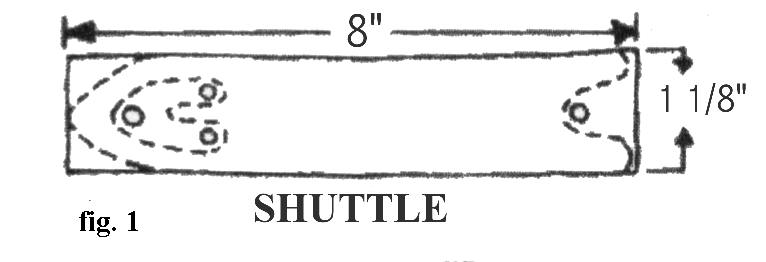 To make shuttle: Cut a piece of 18' x 3/16" wood 8" long. Drill out holes at the points shown and saw out the area along the dotted lines with a scroll saw. Sand the edges smooth.
To make shuttle: Cut a piece of 18' x 3/16" wood 8" long. Drill out holes at the points shown and saw out the area along the dotted lines with a scroll saw. Sand the edges smooth.
To make gauge stick: Cut a piece of wood 2" wide 6" long 1/8" thick. Round the ends and sand them smooth.
TWO PERSON HAMMOCK
-
3 pounds of Hammock Cord
-
1 Gauge Stick
-
1 giant Netting Shuttle
-
2 Hardwood Bars, 1½" x 1½", 48" long
-
2 rings, 2" - 3" diameter
 START: Cut a three foot piece of twine; square knot the ends. Hang the loop from a handy nail, hook or door knob.
START: Cut a three foot piece of twine; square knot the ends. Hang the loop from a handy nail, hook or door knob.
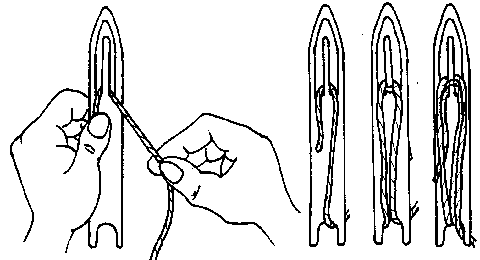
WIND: Load shuttle with Hammock Cord (see pictures). Not too full for the first row. Tie free end to the loop.
CASTING ON: Hold gauge stick in your left hand. Wrap the shuttle cord once around the stick-down in front and up behind. Pull the shuttle up through the starting loop. Holding shuttle cord loop tight around the gauge stick, half hitch around both sides of the starting cord. Repeat, until you have made 20 loops around the gauge stick (30 for two person hammock). Snug and even. 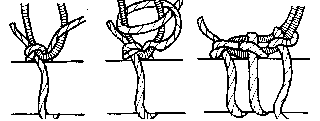
FIRST ROW: Pull out the gauge stick. Rotate the work, so the shuttle is on the left side. Hold the gauge stick in your left hand, just under the work. Bring the shuttle cord down in front, up behind gauge stick, through the first loop, and around the loop in a half hitch. Repeat, through each loop in turn, evenly.
ADDING TO SHUTTLE: Soon, your shuttle is going to be exhausted. Reload, as above. Wind on as much as the shuttle will take. Knot the free end to the end of the old cord with a square knot.
SECOND ROW: Rotate the work, so the shuttle cord is on the left. Proceed as for the first row. Repeat until done. Fifty four rows are about seven feet. Work longer or shorter.
ALONG THE WAY: Any time after the second row, cut your starting cord and pull it free from the top row of loops. Support the piece as you add rows by any convenient means that holds it evenly - a dowel threaded straight across a row of loops, for instance.
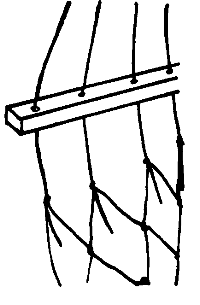 MOUNTING: Drill 20 holes (30 for two person hammock) through each 1½" x 1½" hardwood bar, 1½" apart from center to center and 2¼" in from each end. Make the end holes ¼" to 5/16" diameter, the rest from 3/16" to ¼" diameter. Cut forty 50" long cords, twenty for each end (sixty for a two person hammock). Loop the first cord through a ring, thread both ends through left hand hole in hardwood bar. Overhand knot through top left hand loop in hammock net. Fasten each cord, in turn, through bar to loops in net. Do both ends.
MOUNTING: Drill 20 holes (30 for two person hammock) through each 1½" x 1½" hardwood bar, 1½" apart from center to center and 2¼" in from each end. Make the end holes ¼" to 5/16" diameter, the rest from 3/16" to ¼" diameter. Cut forty 50" long cords, twenty for each end (sixty for a two person hammock). Loop the first cord through a ring, thread both ends through left hand hole in hardwood bar. Overhand knot through top left hand loop in hammock net. Fasten each cord, in turn, through bar to loops in net. Do both ends.
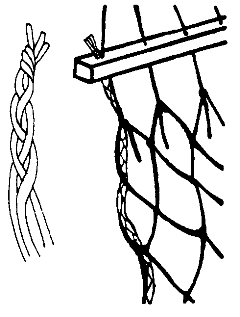 SIDE BRAIDS: You need the net to sag in the middle so it holds a body snug. Make two 3-cord braids 3" shorter than the stretched out length of the hammock net - one for each side. Remember that braids end up about 10% shorter than their component cords - cut generously and trim later. Thread one end through the outermost hole in support bar. secure with an overhand knot. Weave in and out through the outside meshes. Thread through the bar at the far end, the outside hole, and secure with overhand knot. Repeat on the other side.
SIDE BRAIDS: You need the net to sag in the middle so it holds a body snug. Make two 3-cord braids 3" shorter than the stretched out length of the hammock net - one for each side. Remember that braids end up about 10% shorter than their component cords - cut generously and trim later. Thread one end through the outermost hole in support bar. secure with an overhand knot. Weave in and out through the outside meshes. Thread through the bar at the far end, the outside hole, and secure with overhand knot. Repeat on the other side.


















 To make shuttle:
To make shuttle:



 SIDE BRAIDS:
SIDE BRAIDS:






















